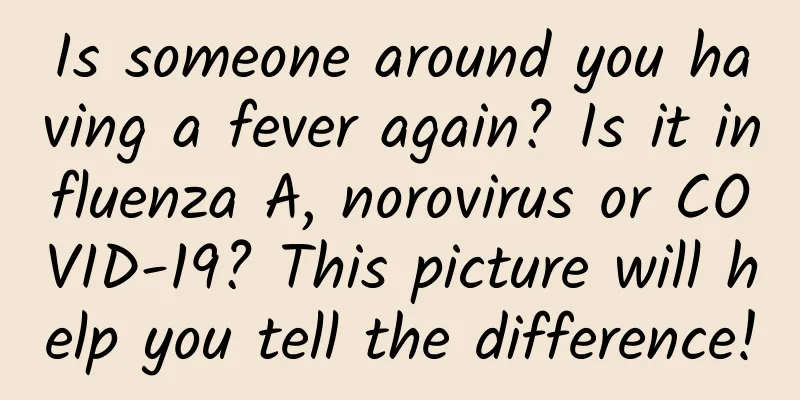A piece of sugar cane was eaten and sent to the ICU! Don't eat this kind of sugar cane, it can cause death

|
In winter, bundles of sugar cane are often seen in prominent positions at fruit stalls on the street and beverage shops near subway stations. Sugar cane in winter is crisp and sweet. When you take a bite, the sweet juice immediately fills your mouth. It is so delicious that you can't stop eating it. But delicious sugarcane may turn into deadly "poison". News about poisoning from eating sugarcane is not uncommon, so everyone must pay attention. Image source: Weibo screenshot So, why is sugarcane poisonous? How to tell? Today's article will explain it clearly. Don't eat a single bite of sugarcane if it has a red core Although sugarcane is sweet, if you find that its core has turned red, don't eat it as it may contain deadly toxins. After sugarcane is harvested, it is likely to become moldy and contaminated by Arthrinium spp. due to improper storage during transportation and sales. This mold will produce a highly toxic toxin during its growth and reproduction process - 3-nitropropanoic acid (3-NPA). 3-NPA is a strong neurotoxin. Once absorbed by the human body, it can cause damage to the central nervous system in a short period of time, leading to symptoms such as dizziness, headache, convulsions, and in severe cases, cerebral ischemia and necrosis, respiratory failure, and even death. Some poisoned patients may also suffer from language and movement disorders. Especially for children, their detoxification organs such as liver and kidney are not fully developed and their resistance is weak. Once children are poisoned by moldy sugarcane, they are more likely to develop serious illness. Copyright images in the gallery. Reprinting and using them may lead to copyright disputes. One of the most important characteristics of sugarcane mold is that the sugarcane core turns red or reddish brown. This is because the crazy reproduction of Nyctosporium produces red nitric acid substances. In addition, sugarcane that becomes soft, hairy, or has a strange smell may also be at risk of mold, so try not to eat it. At this point, someone might ask: Can we eat it if we remove the red core? No! No! No! (Important things should be said three times) After the sugarcane is invaded by mold, the mycelium has extended to every part of the sugarcane. Except for the moldy part, the intact part actually also contains toxins, but these toxins do not turn red, so they cannot be seen with the naked eye. How to buy safe and sweet sugarcane? Choose sugar cane with a hard texture first. If you find that the sugar cane has become soft, has a red core, or smells strange, do not buy or eat it. Many people hope to choose sugar cane that is sweet and delicious. In fact, the varieties of sugar cane sold in the market that can be chewed directly are basically the same, and the taste difference is not much. So don't worry too much about how to choose. However, for convenience and good chewing, you can choose a long and thin one. A little reminder: Sugarcane has a high sugar content, so you should eat it in moderation and not eat too much. Especially for people with diabetes and high blood sugar, they should pay more attention to eating less sugarcane. If children cannot spit out sugarcane residue, they may easily choke on it when eating sugarcane, causing the risk of suffocation. It is not recommended to chew sugarcane directly. Two things most people don’t know about sugarcane 1. Sugarcane is not actually a fruit Sugarcane is a tropical herbaceous plant that belongs to the same family as bamboo, wheat, corn and rice. It is a typical tropical crop that likes light and heat. Sugarcane is very tall, up to 5-6 meters in size, with long, slender leaves like long knives and flowers on its head that are in spikes like reeds. The stems are divided into many sections, and buds can grow at the sections (so-called tillers [niè]). Its rhizomes store a lot of sugary juice - that is, "sucrose". Sugarcane later spread northward, and Indians were the first to extract crystallized sugar from sugarcane juice. During the Warring States Period in the 3rd century BC, sugarcane was introduced to southern China and was promoted throughout the country around the Tang Dynasty. Copyright images in the gallery. Reprinting and using them may lead to copyright disputes. Generally speaking, sugarcane matures around October each year and can be eaten in March or April of the following year. It is no wonder that it has become a common "fruit" in winter. The reason for adding quotation marks is that strictly speaking, it is not a fruit. It does not produce fruit, but stems. Different types of sugarcane have different colors, stem thickness, sweetness, juice and fiber content, etc. However, according to their uses, there are two main types: sugar production and fresh consumption. Both fresh consumption and sugar production are the result of artificial hybridization. Sugarcane for fresh consumption (direct chewing) is also called "fruit cane". It has the characteristics of high water content, high sugar content and low fiber content. In China, the sugarcane we often chew is Chinese bamboo cane (S. sinense). This kind of sugarcane not only has a sweet taste (high sugar content), but also has rich juice, which is very suitable for direct chewing. 2. Sugarcane: An important economic commodity On the afternoon of December 14, 2023, General Secretary Xi Jinping visited Laibin City, Guangxi, inspected tens of thousands of acres of sugarcane forests and mechanized harvesting scenes, and encouraged them to play a greater role in ensuring national sugar industry security and promoting sugarcane farmers' income growth and wealth. In addition to being eaten fresh, sugarcane has a more important function - making sugar. Currently, 80% of the sugar produced in the world each year comes from sugarcane. Sugarcane is harvested, juiced, purified, dried and processed to produce the various types of sugar we eat. Image source: Edited by When it comes to sugar, many people may think that it is unhealthy and does not seem to be a good thing. In fact, sugar has played an important role in world history. Until now, sugar is still an important economic commodity in various countries. For a long time in history, sugar was a very expensive commodity. Because of its high value, countries around the world used the pursuit of sweetness to engage in various struggles for interests and power, changing the world pattern more than once. It has only been in the last one or two hundred years that sugar has become cheap and available to every household at any time. As for the fact that sugar is not good for health, my country's per capita annual sugar consumption is less than half of the world average. my country is an important producer and consumer of sugar. Sugarcane cultivation plays an important role in my country's agricultural economy. In my country, Guangxi, Yunnan and Guangdong provinces occupy the top three positions in sugarcane production, accounting for more than 90% of the total national production. Sugar is not only an indispensable daily necessity, but also a basic raw material for more than 120 industries such as food, beverages, pharmaceuticals and chemicals. References [1] A History of the World in a Grain of Sugar (Japanese), written by Kitagawa Minoru, translated by Zhao Ke, published by Nanhai Publishing Company in January 2018 [2] A Draft History of Latin America, by Li Chunhui, published by the Commercial Press in April 1983 [3] Sweetness and Power: The Place of Sugar in Modern History (USA), by Westminster, translated by Wang Chao and Zhu Jiangang, Commercial Press, 2010. [4] Chinese National History. Changing History Leads to Sin: Sugarcane's Journey Around the World [5] Chen Shizhi, Lan Yanhua. History of Chinese Sugar (I): The social background and historical evolution of the development of my country's sugar factories before the founding of the People's Republic of China [J]. Guangxi Sugar Industry, 2019, (01): 45-48. [6] Chen Shizhi, Lan Yanhua. The history of Chinese sugar industry (II): the development of sugarcane planting industry in my country before the founding of the People's Republic of China [J]. Guangxi Sugar Industry, 2019, (02): 45-48. [7] Chen Shizhi, Lan Yanhua. The history of Chinese sugar industry (Part 3): the relationship between sugarcane farmers and sugar factories, local sugar and machine-made sugar before the founding of the People’s Republic of China, and the recovery of the sugar industry before the Anti-Japanese War [J]. Guangxi Sugar Industry, 2019, (05): 45-48. [8] Zhang Yu, Tao Lian'an, An Rudong, et al. Evaluation of economic breeding value of 27 sugarcane hybrid combinations[J]. Seed, 2023, 42(06): 126-131. DOI: 10.16590/j.cnki.1001-4705.2023.06.126 [9] Zhou Huiwen, Lu Guijun, Wu Jianming, et al. Research progress on the development of sugarcane seed industry in China[J]. Guangxi Science, 2023, 30(03): 421-433. DOI: 10.13656/j.cnki.gxkx.20230710.001 [10] Bao Guoyu, Lan Yanhua. Development history and lessons learned from comprehensive utilization of sugarcane in my country[J]. Sugarcane Industry, 2023, 52(01): 79-87. This article is a work of Science Popularization China-Starry Sky Project Produced by: Science Popularization Department of China Association for Science and Technology Producer: China Science and Technology Press Co., Ltd., Beijing Zhongke Xinghe Culture Media Co., Ltd. Author: Ruan Guangfeng, Deputy Director of Kexin Food and Health Information Exchange Center Review丨Zhang Yu, Researcher, Chinese Center for Disease Control and Prevention, Doctor of Medicine |
<<: Who says wild boars can’t eat fine bran? They don’t really want it!
Recommend
How much does it cost to develop a Hezhou housekeeping mini program?
Hezhou housekeeping applet development price 1. D...
El Nino alert! Is the hottest year in history coming?
Recently, people in many areas have found that it...
Redmi and BYD have reached a cooperation, Redmi K30 Pro will become the "car key" of BYD cars
Recently, Redmi released the Redmi K30 Pro produc...
Apple releases iOS16 Beta 2! Let's take a look at what's updated
Apple recently pushed the iOS/iPadOS 16 Developer...
The Wentian experimental cabin has been relocated, and here come the hard-core knowledge points!
At 12:44 on September 30, after about an hour of ...
Changan Automobile Technology Ecosystem Conference User Forum was held, with four major measures to ensure the construction of a new service platform
On August 24, the 2021 Changan Automobile Technol...
The new platform enables Great Wall Motors to sell 618,211 vehicles from January to June, a year-on-year increase of 56.5%!
On July 8, Great Wall Motor Co., Ltd. (stock code...
Xi'an's unique men's sauna club, come and experience it with curiosity
Xi'an Bath Club East Suburbs, South Suburbs, ...
Application of Beidou in hydrological monitoring: Beidou + hydrology = early warning of heavy rain!
...
For a sprained joint, should you apply heat or cold?
In daily life, various joint sprains are common, ...
Mango TV is going further and further on the old path of CNTV
Recently, with the "breast reduction" o...
What are the methods for app promotion? Share 5 tips!
As the most important distribution channel for Ap...
Product operation: 5 steps to build a complete user recall system!
This article mainly introduces how to build a rec...
Money-Making Calendar 2021, why is the Money-Making Calendar 2021 so popular?
What is the art of making money? There are three ...









